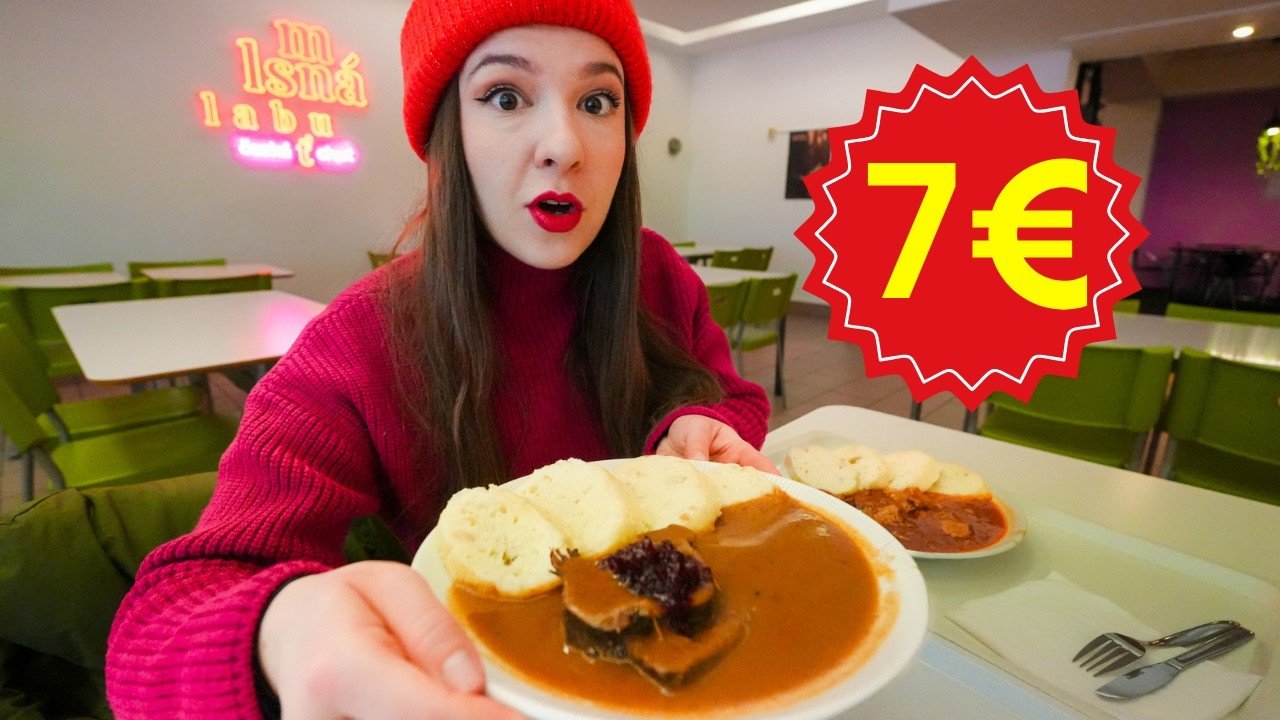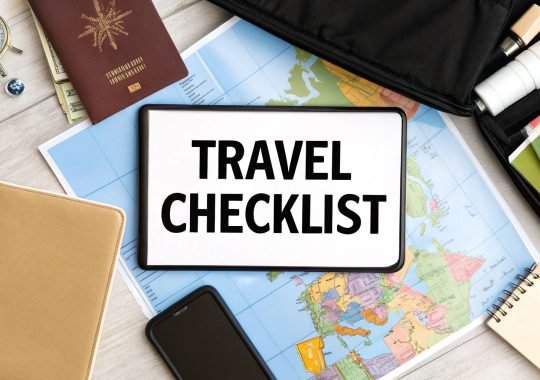Planning a trip on a budget isn’t about restriction; it’s about being intentional. It’s about making sure every dollar you spend goes toward the experiences you’ll remember for a lifetime. Think of it less as a set of rules and more as a blueprint that turns your travel dream into a real, actionable plan.
Build Your Budget Travel Blueprint
Before you even glance at flights or hotels, you need to figure out what “budget travel” really means to you. Is it about scoring the cheapest hostel dorms so you can splurge on Michelin-star dinners? Or is it about camping under the stars to free up cash for adrenaline-pumping adventures?
There’s no single right answer. The first, most critical step is figuring out your own travel style. Honing your skills on how to budget money effectively in your daily life is the perfect training ground for planning a trip. A solid travel budget isn’t meant to hold you back—it’s the tool that empowers you to travel more, travel better, and leave the financial stress at home.
H3: Define Your Travel Priorities
So, what gets you most excited about this trip? Is it the food? The culture? The pure, unadulterated relaxation? Maybe it’s all about the adventure.
Answering this question is key because it tells you where to point your money. If you’re a foodie, you might allocate more to restaurants and local markets while saving on lodging. A history buff, on the other hand, might prioritize museum passes and guided tours, opting for simpler accommodations.
The most common mistake I see people make is trying to spread their budget evenly across everything. Don’t do it. Instead, pick one or two things that matter most and give yourself permission to spend on them. Then, get ruthless about cutting costs everywhere else. This is how you make sure your money buys you memories, not just stuff.
H3: Break Down Your Core Costs
Once you know what you value, it’s time to get practical. Most of your travel budget will be eaten up by three major categories. I call them the “Big Three.”
- Transportation: This is how you get there and how you get around. It includes your main flights, train tickets, or gas, plus local transit like buses, subways, and ride-shares once you’ve arrived.
- Accommodation: This is where you’ll sleep each night. It could be anything from a hotel or an Airbnb to a hostel dorm bed or a guesthouse.
- Food & Drink: This covers everything you’ll eat and drink daily, from grabbing groceries and street food to enjoying a nice dinner out.
This chart gives you a good visual of how daily budgets can break down by region.
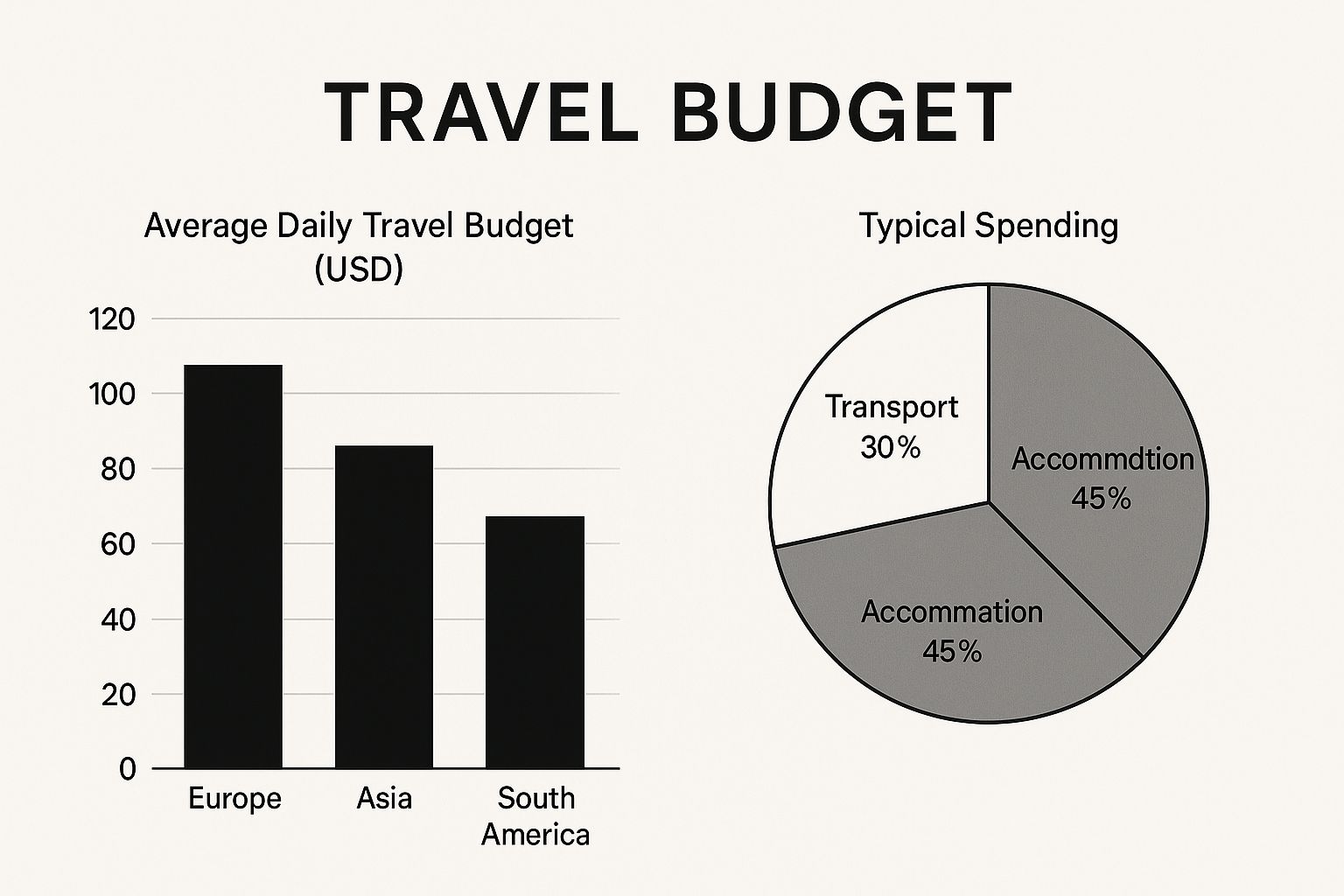
As you can see, where you go makes a huge difference, but accommodation and food almost always take the two biggest slices of the pie.
H3: Sample Daily Budgets by Travel Priority
To help you get started, here’s a sample table showing how your daily spending might look depending on what you prioritize. Think of this as a rough guide to kick off your own planning.
| Travel Priority | Estimated Daily Budget (Excluding Flights) | Typical Lodging | Typical Food |
|---|---|---|---|
| The Foodie | $100 – $150+ | Budget-friendly hostels or guesthouses | Street food, market finds, one splurge meal |
| The Adventurer | $80 – $120 | Camping or basic private rooms | Groceries, packed lunches, simple local cafes |
| The Culture Vulture | $70 – $110 | Centrally-located budget hotels | Mix of groceries and casual restaurants |
| The Beach Bum | $60 – $100 | Beachfront bungalows or affordable rentals | Mostly groceries, happy hour drinks, beach snacks |
These numbers are just a starting point, of course. Your actual costs will depend heavily on your destination and how strictly you stick to your plan.
H3: Account for the “Other” Stuff
Beyond the Big Three, a bunch of other costs can sneak up on you if you aren’t prepared. Don’t let them derail your budget.
- Pre-Trip Costs: This is money you’ll spend before you even lock the front door. Think visas, travel insurance, vaccinations, or any special gear you need to buy for the trip.
- Activities & Entrance Fees: This bucket is for all the fun stuff—museum tickets, guided tours, national park fees, shows, and anything else on your must-do list.
- Miscellaneous Spending: This is your buffer for everything else. Souvenirs, unexpected taxi rides, laundry, tips, or that spontaneous gelato you just have to try. A safety net of 10-15% of your total budget is a smart move.
By creating this detailed blueprint, you go from a vague “I want to save for a trip” goal to a specific target number. If it all feels a bit much, take a deep breath. Start by checking out some essential budget travel tips for smarter travel to see where you can easily cut back. Getting this foundation right makes every other part of your planning easier and more effective.
Find Flight Deals Other Travelers Miss
Transportation often feels like the single biggest budget-breaker on any trip. I get it. But finding an affordable flight is more of a science than a stroke of luck. If you master a few key strategies, you can consistently put the best deals right at your fingertips, letting you save that cash for the experiences that really matter.
The first step in any successful flight hunt is knowing which tools to use and when. For that initial, wide-net search, flight aggregators are your best friend. They do the heavy lifting, pulling in prices from hundreds of airlines and online travel agencies all at once.
Master the Art of Flight Aggregators
Think of sites like Google Flights, Skyscanner, and Momondo as your starting lineup. Their real power lies in their flexibility. Instead of being locked into a specific date, you can view prices across an entire month to instantly spot the cheapest days to fly. This visual approach to budget travel planning is a total game-changer.
For example, just look at the Google Flights calendar view. It makes comparing costs day-by-day incredibly simple.
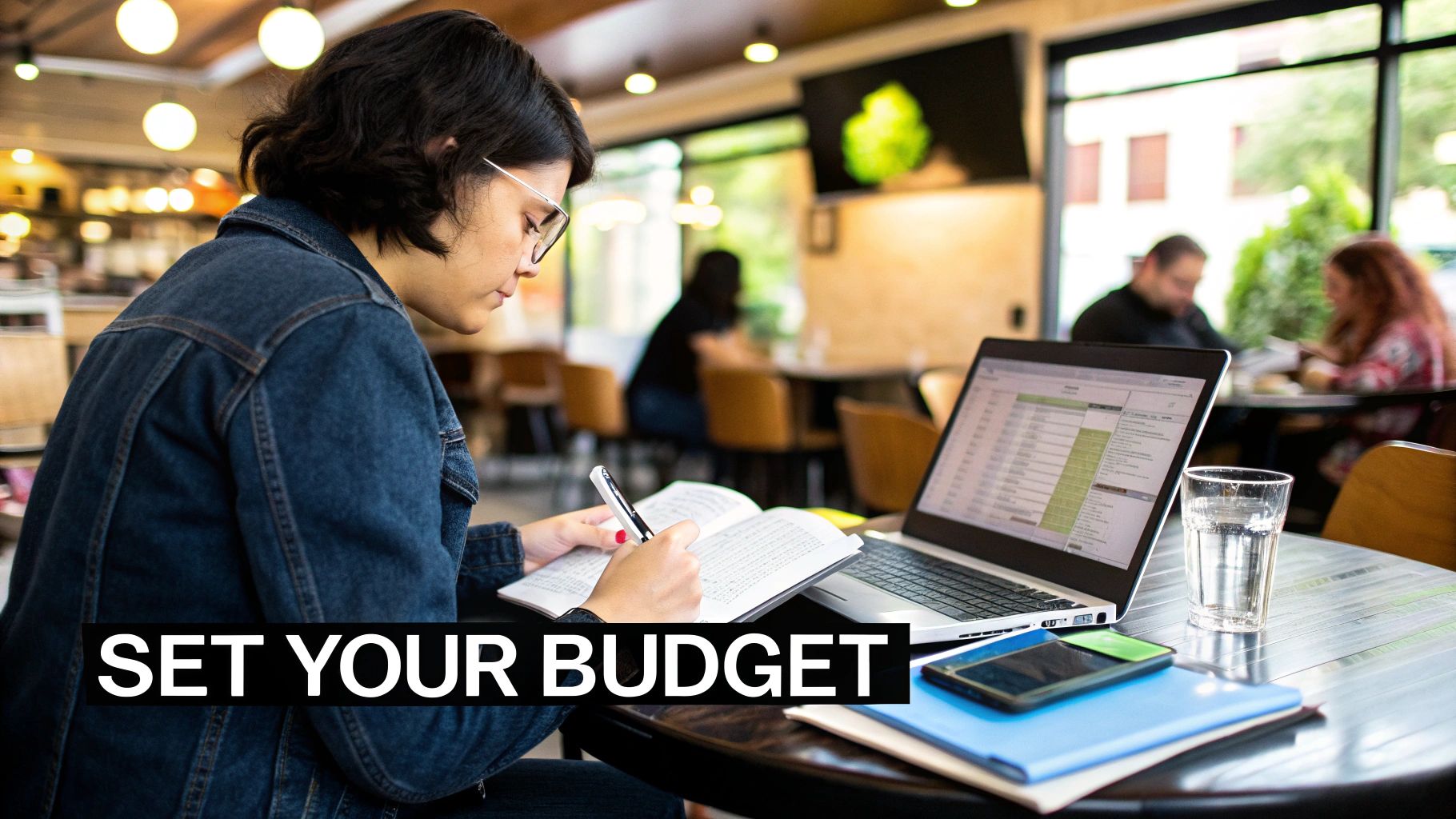
The key takeaway here is how quickly you can spot price patterns. Those green-highlighted dates show the lowest fares, allowing you to shift your plans by just a day or two and potentially save hundreds of dollars.
Once you find a great deal on an aggregator, here’s my advice: always try to book directly with the airline. Clicking through might take an extra step, but it can save you from major headaches with third-party customer service if your flight gets changed or canceled down the line.
Pro Tip: Don’t just search once and give up. Set up fare alerts for your desired route. Let the technology do the work for you by sending an email the moment prices drop. This hands-off approach is how I’ve scored some of my all-time best deals without spending hours glued to my screen.
Advanced Tactics for Deeper Savings
Ready to go beyond the basics? A few next-level techniques can uncover even lower prices that most travelers completely miss.
- Use a VPN: Airlines sometimes show different prices based on your location. By using a Virtual Private Network (VPN) to change your digital location to another country—especially your destination country—you can sometimes trick the system into showing you lower fares.
- Fly into Secondary Airports: Major international hubs aren’t always your cheapest bet. Look for smaller, secondary airports nearby. A budget flight to an alternative airport plus a short train or bus ride can often be significantly cheaper than flying directly into the main one.
- Consider Timing and Market Trends: While the old “book on a Tuesday” myth is pretty much debunked, timing is still everything. The sweet spot is generally 1-3 months out for domestic flights and 2-8 months for international trips. Airfare is also tied to bigger economic trends. For instance, after a recent global price hike, average ticket prices in North America are projected to see a 2.9% decline. Staying aware of these regional travel price forecasts on GBTA.org is a core part of smart budget travel planning.
Don’t Forget Ground Transportation
Your transportation budget doesn’t end when the plane lands. How you get around your destination is just as important for keeping costs in check.
For travel between cities, especially in Europe and Asia, trains are often your best friend. Booking high-speed or long-distance train tickets weeks or even months in advance can save you up to 70% compared to buying them on the day of travel.
Mastering local bus networks is another budget traveler superpower. It might feel intimidating at first, but it’s almost always the absolute cheapest way to explore a city. A little pre-trip research on routes and payment methods goes a long, long way.
And a final thought: only consider a rental car if you’re traveling with a group or visiting a rural area where public transport is sparse. Otherwise, the costs of gas, insurance, and parking will eat up your savings in no time.
Choose Accommodations That Save You Money
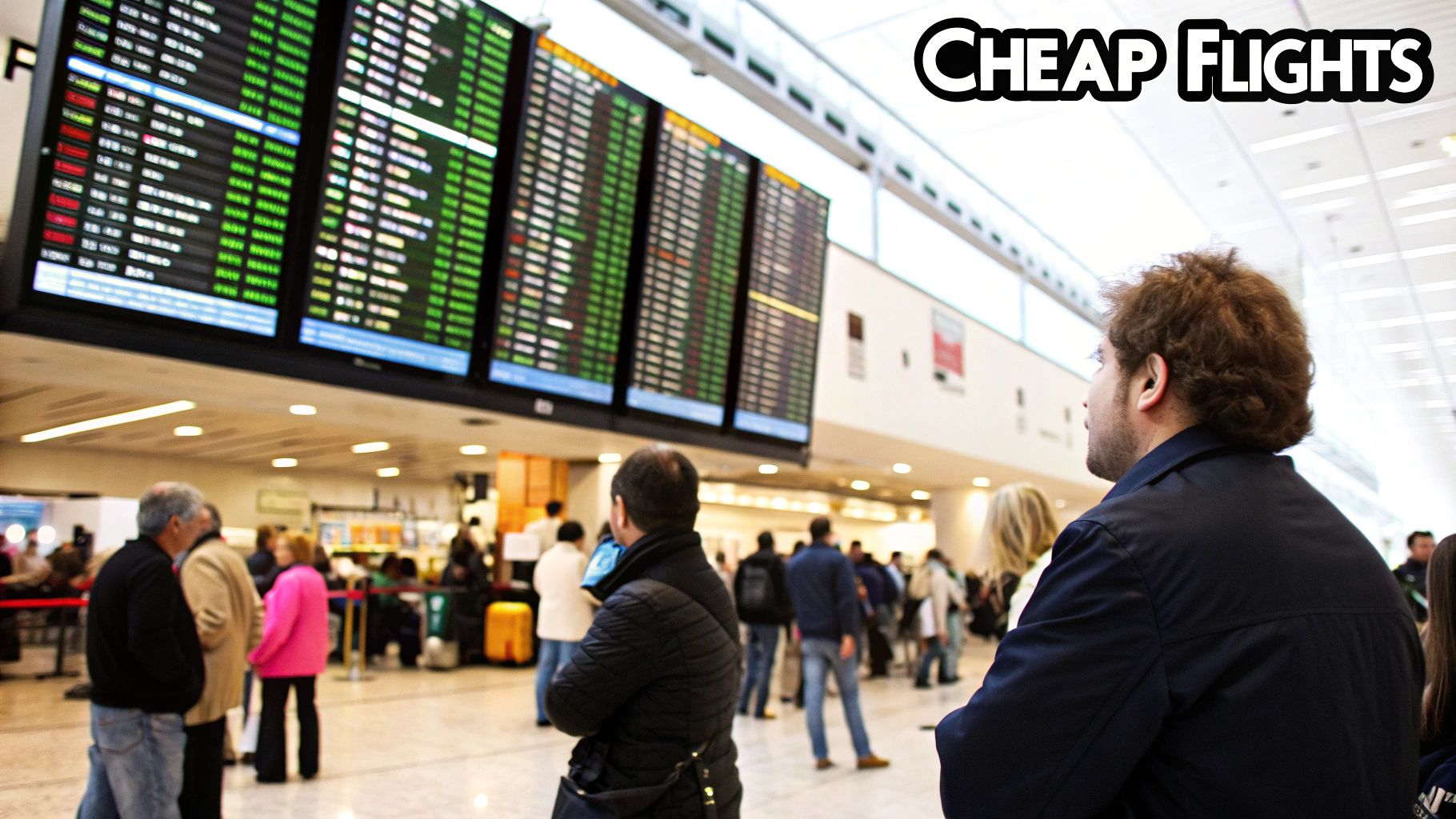
Where you sleep each night can make or break your travel fund. But smart budget travel planning isn’t just about finding the cheapest possible bed. It’s about finding the best value for your money and, just as importantly, for your travel style.
Let’s move beyond the stereotype of a cramped backpacker dorm. Today’s travel landscape is filled with incredible options, from private rooms in stylish guesthouses to entire apartments that give you a taste of local life. You can even find unique opportunities like house-sitting that bring your accommodation costs down to almost zero. Your choice here will shape both your daily spending and your entire experience.
Look Beyond Traditional Hostels
While hostels are a classic for budget travelers, they’ve come a long way. Many now offer private rooms with en-suite bathrooms, giving you a hotel-like experience with the huge perk of shared social spaces and kitchen facilities. Being able to cook your own breakfast is a massive money-saver.
But don’t stop your search there. Consider these fantastic alternatives:
- Guesthouses and Local Inns: These are often family-run spots that offer a more personal and authentic stay. You get insider tips from actual locals and a comfortable room, frequently for less than a generic hotel.
- Apartment Rentals: Platforms like Airbnb or Vrbo are a godsend, especially for group trips or any stay longer than a few days. That kitchen access is a budget game-changer, letting you prep breakfast and pack lunches instead of eating out for every meal.
- House-Sitting: This is the ultimate budget hack for flexible, adventurous travelers. Websites connect you with homeowners who need someone to care for their home and pets in exchange for free lodging. It’s an amazing way to live like a local.
A key part of deciding is being honest with yourself. Are you a light sleeper who would be miserable in a 12-person dorm? If so, spending a little extra on a private room just outside the city center is a much better investment in your trip’s success.
Weigh Location Versus Price
It’s the timeless traveler’s dilemma: pay a premium for a central spot or save cash by staying further out? There’s no single right answer, but you can make a smart choice with some quick math.
Figure out the potential daily transportation costs from a cheaper, more remote location. Will you be spending $10-15 per day on buses or subways just to get to the main sights? Sometimes, that “cheaper” room ends up costing more once you add in transit fees and, crucially, lost time.
On the flip side, staying in a residential neighborhood can offer a more authentic experience, with better access to local markets and non-touristy restaurants. My personal rule of thumb is to map out my top three “must-see” sights and find lodging with easy, affordable access to them, even if it’s not right on the main square.
Decode Reviews and Uncover Hidden Costs
Reviews are your best friend when booking affordable places, but you need to learn how to read between the lines. Don’t just glance at the star rating; scan the comments for recurring themes. If three different people mention the noisy street or weak Wi-Fi, you should probably believe them.
You also have to play detective when it comes to hidden fees. Many apartment rentals tack on significant cleaning or service fees that only pop up on the final checkout page. Always click through the booking process right to the very last step before you pay to see the true, all-in cost.
For longer stays of a week or more, don’t be afraid to reach out to the host or manager directly. A polite message asking if they offer a discounted rate for a longer booking can often work wonders. The worst they can say is no. For an even deeper dive, you can learn how to negotiate rent effectively to secure an even better deal. Finding the right place isn’t just about saving money—it’s about finding a comfortable, safe base that makes your whole adventure better.
Eat Incredibly Well on a Small Budget
Food is one of the absolute best parts of traveling. It’s a direct line to the heart and soul of a new place. And let me be clear: a tight budget should never mean you’re stuck eating bland, sad meals. Real budget travel planning for food isn’t about skipping meals. It’s about eating smarter, more authentically, and, honestly, way more deliciously than the tourists overpaying at the main square.
The single biggest move you can make is to book a place with a kitchen. It doesn’t have to be fancy—even a small kitchenette found in most modern hostels, guesthouses, or apartment rentals is a complete game-changer. This simple amenity means you can whip up your own breakfast and pack a lunch, easily saving you $15-$25 per day. That’s cash you can put toward an incredible dinner out or a unique food tour.
Hunt for Authentic Local Flavors
If you want to eat incredibly well for less, you just have to follow one simple rule: eat where the locals eat. This means getting off the main tourist drag and wandering into the residential side streets.
My go-to strategy is what I call the “long line rule.” If I stumble upon a street food stall or a tiny, no-frills restaurant with a long line of local people snaking out the door, I get in that line. No questions asked. It’s a nearly foolproof sign that the food is fantastic and priced right. Tourist traps just don’t get that kind of loyal, local following.
Your first stop in any new city should be the local market. It’s a feast for the senses and a huge win for your wallet.
- Sample Everything: Don’t be shy! Vendors are often happy to offer you tastes of cheese, olives, or cured meats. It’s the perfect way to try before you buy.
- Create a Gourmet Picnic: Grab a fresh loaf of bread from a bakery, some interesting local cheese, fresh fruit, and maybe a bottle of regional wine. You’ve just created a memorable, high-quality meal for a tiny fraction of what a restaurant would charge.
- Look for Prepared Food Stalls: Markets are full of stalls selling hot, ready-to-eat meals for local workers on their lunch break. This is your ticket to a cheap and truly authentic lunch.
Master the Art of the Lunch Special
In so many countries, especially across Europe and Latin America, lunch is the main event. Restaurants cash in on this by offering a menu del día, plat du jour, or a set lunch menu that is an unbelievable bargain.
For a fixed, low price, you’ll often get an entire multi-course meal—an appetizer, a main course, dessert, and even a drink. We’re talking dinner-quality food served at lunchtime for sometimes half the price. By making lunch your big meal out, you can have a light, cheap dinner back at your rental and slash your daily food costs without missing a single bite of the local cuisine.
I once had an amazing three-course meal in Spain that came with fresh fish, soup, dessert, and a glass of wine for just €12. I found it by walking two streets away from the main plaza, where a nearly identical meal was advertised for over €30. It pays to explore!
Avoid Common Food Budget Traps
Finally, eating smart means knowing what not to do. Walk right past any restaurant that has glossy, multi-language menus and a host out front trying to lure you inside. These are classic red flags for overpriced, mediocre tourist food.
Also, watch your drink costs. A few sodas or beers with dinner can easily double your bill. Always ask for tap water (use the local term, otherwise you’ll get pricey bottled water by default) or take advantage of the drink that often comes with those great lunch specials.
By mixing and matching these strategies, you’ll find yourself eating like a king while staying firmly on budget.
Manage Your Money and Expenses on the Road
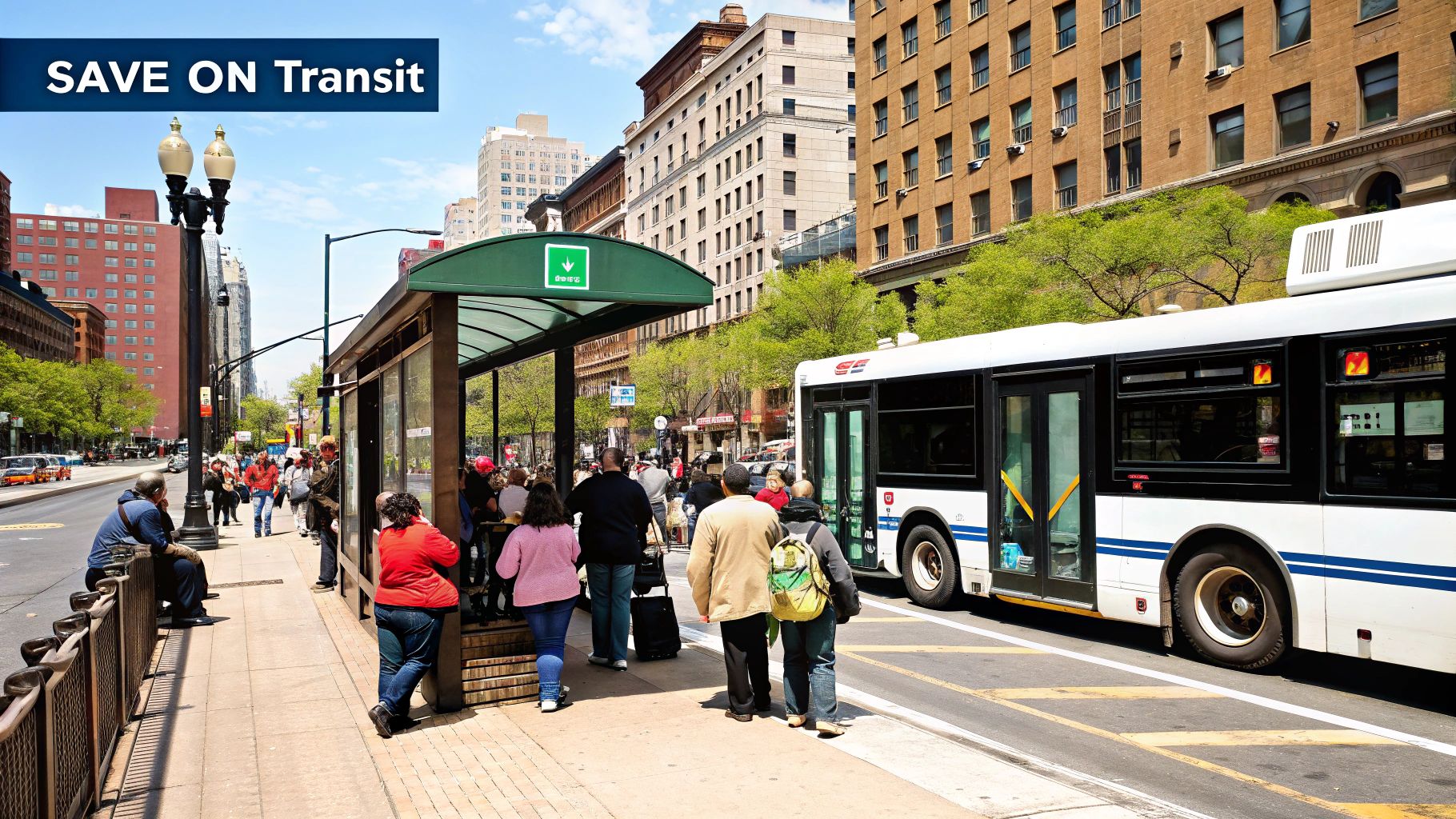
So you’ve planned your trip and booked your tickets. Fantastic! But the real test of your budget travel skills begins the moment you touch down. Suddenly, you’re dealing with a new world of currencies, payment methods, and daily temptations.
How you manage your money on the road is what separates a good trip from a great one. It’s the skill that lets you stay on track without ever feeling like you’re missing out. The biggest hurdle? Getting access to your cash safely and without getting hammered by fees. Your bank card from home might seem like the simplest choice, but it can hide some nasty surprises like high foreign transaction fees and terrible exchange rates. A little prep work here goes a very long way.
Accessing Your Cash Like a Pro
I’ve found the best way to handle this is with a two-card strategy: one travel-friendly credit card for bigger purchases and a low-fee debit card for pulling out cash at ATMs. This combo gives you the most flexibility and saves you a ton of money.
Travel Credit Cards: Your number one priority should be finding a card with zero foreign transaction fees. This feature alone can save you around 3% on everything you buy overseas. They also offer way better fraud protection than debit cards, which is a massive relief when you’re thousands of miles from home. I use mine for things like hotels, car rentals, and sit-down restaurant meals.
Low-Fee Debit Cards: For cash, you need a debit card that won’t punish you for using it abroad. Some online banks and credit unions are fantastic for this, offering accounts that either waive or fully reimburse international ATM fees. Having local currency on hand is a must for those authentic experiences—think street food, market treasures, and local bus rides.
Pro Tip: When you use a card machine or ATM, you might be asked if you want to be charged in your home currency. This is called “Dynamic Currency Conversion.” Always say no. It seems helpful, but it’s a sneaky way to lock you into a terrible exchange rate. Always choose to pay in the local currency.
This smart approach to spending is more critical than ever. We’re seeing a huge rebound in travel, with international visitor spending projected to hit an incredible $2.1 trillion next year. While that’s great for the industry, it could mean higher prices in popular spots. A solid money plan is your best defense.
Track Your Spending in Real Time
A budget is just a piece of paper (or a spreadsheet) if you don’t actually track what you’re spending. Don’t fall into the trap of waiting until you get home to add up receipts—by then, the damage is done. The solution is simple: use a budgeting app to log every expense right as it happens.
On my trips, I swear by apps like Tripcoin or Trail Wallet. You can set a daily budget and enter your spending in whatever currency you’re using. A quick glance tells you if you’re on track for the day, which lets you make smart adjustments on the fly. Splurged on a fancy dinner last night? No problem. You know to balance it out with a cheap-and-cheerful picnic lunch today.
Fill Your Itinerary with Free and Low-Cost Activities
Honestly, some of the best travel memories I have cost me next to nothing. A huge part of keeping your budget in check on the road is weaving these amazing, affordable experiences into your plans.
Here are a few of my go-to strategies:
- Embrace Free Museum Days: So many world-class museums have free admission on certain days or evenings. A quick Google search before you go can save you a surprising amount on entry fees.
- Take a Self-Guided Walking Tour: I love downloading a free audio guide or just following a route I found on a travel blog. It’s an incredible way to get to know a city’s history and vibe at your own pace, no expensive tour guide needed.
- Enjoy the Local Parks and Public Spaces: Think about a lazy afternoon in Paris’s Jardin du Luxembourg or watching the sunset from a scenic viewpoint. These moments are what travel is all about, and they’re completely free.
- Seek Out Local Markets: Even if you don’t buy a thing, just wandering through a bustling local market is an activity in itself. It’s a vibrant, chaotic, and authentic slice of daily life.
By mixing these kinds of activities with smart food choices, you can make your travel fund stretch way further. For more ideas on that, check out our guide on how to find affordable eats while traveling. And for more help with managing your finances and finding deals on the road, these helpful travel resources are a great place to start.
Common Questions About Budget Travel Planning
Even after you’ve sketched out your perfect trip, a few practical questions always seem to pop up. It’s totally normal. Getting clear, straightforward answers to these “what ifs” and “how tos” is the key to turning a good plan into a great, stress-free adventure.
Let’s tackle some of the most frequent questions I get. We’ll cut through the noise and give you some no-nonsense advice to help you sidestep common roadblocks and feel completely ready for your trip.
How Far in Advance Should I Plan a Budget Trip?
There isn’t one single magic number here, but I’ve learned from experience that for bigger international trips, you want to start the process 6 to 9 months ahead of time. This isn’t just about snagging an early-bird deal; it’s about giving yourself the gift of time.
This longer runway lets you patiently track flight prices, which often hit their sweet spot around the 3 to 6-month mark before departure. For a domestic getaway, you can usually get away with a shorter lead time of 3 to 4 months.
The real advantage of starting early is having time to research without feeling rushed. You can make smarter decisions, actually learn about your destination, and know a genuinely good deal when you see one, instead of panic-booking something out of desperation.
Is Travel Insurance Worth It for a Budget Trip?
Let me be direct: Yes. A thousand times, yes. In fact, I’d argue it’s one of the most critical, non-negotiable parts of any budget travel planning strategy. Thinking of it as an area to cut costs is a massive, and potentially devastating, mistake.
Think of it as your ultimate financial safety net. A single unexpected medical issue, a lost bag with all your gear, or a sudden trip cancellation could easily wipe out what you saved and cost more than the entire trip itself.
But don’t just grab the first, cheapest policy you find. You have to read the fine print. Make sure it provides solid coverage for the big four:
- Emergency medical care for hospital bills or doctor visits.
- Emergency evacuation in case you need to be transported for a serious medical situation.
- Trip cancellation and interruption to protect your prepaid flights and hotels.
- Lost or stolen baggage to help you replace your essential items.
It’s the most important purchase you hope you never have to use. That small upfront cost is what protects you from a trip-ending financial disaster.
What Are the Best Apps for Budget Travel?
The right tech can be a complete game-changer, turning your smartphone into an incredibly powerful tool for saving money. My own travel toolkit relies on a combination of apps, each one serving a specific, important purpose.
For finding flights, I never trust just one platform. I have a go-to trio:
- Google Flights: Its calendar view is unbeatable for quickly seeing the cheapest days to fly.
- Skyscanner: It casts a wider net and often catches deals on budget airlines that others miss.
- Momondo: I always use this as a final check to make sure no stone was left unturned.
When it comes to a place to sleep, I rotate between Booking.com, Hostelworld, and Agoda. Their filters make it so easy to drill down and find places that fit my budget and needs perfectly.
And for managing money on the road, an app like Tripcoin or Trail Wallet is absolutely essential. They let you track every dollar (or euro, or baht) you spend, so you always know exactly where your budget stands.
How Can I Find Authentic Experiences That Are Also Cheap?
The secret to both saving a ton of money and having a much richer, more memorable trip is simple: get away from the tourist traps. Real, authentic experiences are rarely found where the big tour buses park.
My strategy starts before I even pack my bags. I dive deep into local blogs and travel forums, looking for tips on neighborhood markets, favorite local eateries, and free community events. I also make a point to take a “free” walking tour on my first day in a new city; those guides are fountains of incredible insider knowledge.
Another huge tip is to use public transport exclusively. Ditch the tourist shuttles and taxis. You’ll see the real city, ride alongside locals, and save a surprising amount of cash in the process.
Finally, just talk to people. It’s amazing what you’ll discover. Ask the owner of your guesthouse for their favorite cheap restaurant or a local shopkeeper for their hidden gem in the city. Their advice is almost always better, more genuine, and more valuable than anything you’ll find in a printed guidebook.
At HotelsEscape, we’re dedicated to helping you discover amazing destinations without breaking the bank. From finding hidden deals to sharing insider tips, we provide the resources you need to plan your next adventure. Explore our guides and reviews at HotelsEscape.com to start your journey.
